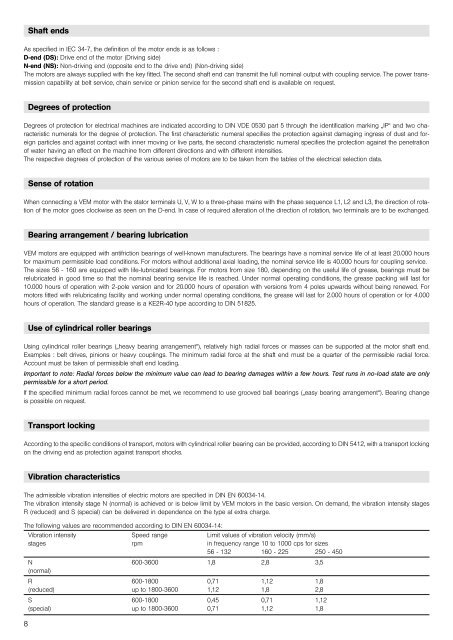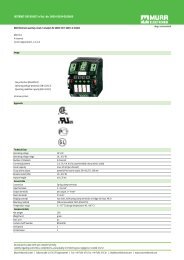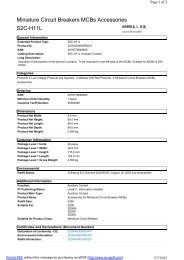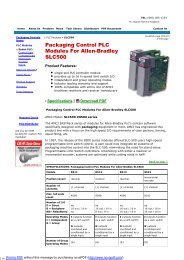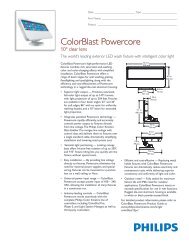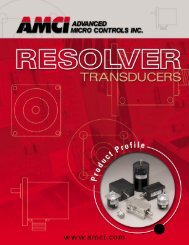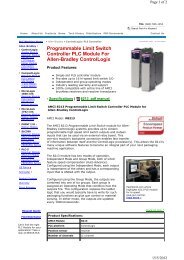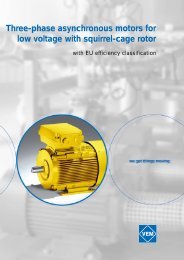for Explosive Atmosphere
for Explosive Atmosphere
for Explosive Atmosphere
- No tags were found...
Create successful ePaper yourself
Turn your PDF publications into a flip-book with our unique Google optimized e-Paper software.
Shaft ends<br />
As specified in IEC 34-7, the definition of the motor ends is as follows :<br />
D-end (DS): Drive end of the motor (Driving side)<br />
N-end (NS): Non-driving end (opposite end to the drive end) (Non-driving side)<br />
The motors are always supplied with the key fitted. The second shaft end can transmit the full nominal output with coupling service. The power transmission<br />
capability at belt service, chain service or pinion service <strong>for</strong> the second shaft end is available on request.<br />
Degrees of protection<br />
Degrees of protection <strong>for</strong> electrical machines are indicated according to DIN VDE 0530 part 5 through the identification marking „IP“ and two characteristic<br />
numerals <strong>for</strong> the degree of protection. The first characteristic numeral specifies the protection against damaging ingress of dust and <strong>for</strong>eign<br />
particles and against contact with inner moving or live parts, the second characteristic numeral specifies the protection against the penetration<br />
of water having an effect on the machine from different directions and with different intensities.<br />
The respective degrees of protection of the various series of motors are to be taken from the tables of the electrical selection data.<br />
Sense of rotation<br />
When connecting a VEM motor with the stator terminals U, V, W to a three-phase mains with the phase sequence L1, L2 and L3, the direction of rotation<br />
of the motor goes clockwise as seen on the D-end. In case of required alteration of the direction of rotation, two terminals are to be exchanged.<br />
Bearing arrangement / bearing lubrication<br />
VEM motors are equipped with antifriction bearings of well-known manufacturers. The bearings have a nominal service life of at least 20.000 hours<br />
<strong>for</strong> maximum permissible load conditions. For motors without additional axial loading, the nominal service life is 40.000 hours <strong>for</strong> coupling service.<br />
The sizes 56 - 160 are equipped with life-lubricated bearings. For motors from size 180, depending on the useful life of grease, bearings must be<br />
relubricated in good time so that the nominal bearing service life is reached. Under normal operating conditions, the grease packing will last <strong>for</strong><br />
10.000 hours of operation with 2-pole version and <strong>for</strong> 20.000 hours of operation with versions from 4 poles upwards without being renewed. For<br />
motors fitted with relubricating facility and working under normal operating conditions, the grease will last <strong>for</strong> 2.000 hours of operation or <strong>for</strong> 4.000<br />
hours of operation. The standard grease is a KE2R-40 type according to DIN 51825.<br />
Use of cylindrical roller bearings<br />
Using cylindrical roller bearings („heavy bearing arrangement“), relatively high radial <strong>for</strong>ces or masses can be supported at the motor shaft end.<br />
Examples : belt drives, pinions or heavy couplings. The minimum radial <strong>for</strong>ce at the shaft end must be a quarter of the permissible radial <strong>for</strong>ce.<br />
Account must be taken of permissible shaft end loading.<br />
Important to note: Radial <strong>for</strong>ces below the minimum value can lead to bearing damages within a few hours. Test runs in no-load state are only<br />
permissible <strong>for</strong> a short period.<br />
If the specified minimum radial <strong>for</strong>ces cannot be met, we recommend to use grooved ball bearings („easy bearing arrangement“). Bearing change<br />
is possible on request.<br />
Transport locking<br />
According to the specific conditions of transport, motors with cylindrical roller bearing can be provided, according to DIN 5412, with a transport locking<br />
on the driving end as protection against transport shocks.<br />
Vibration characteristics<br />
The admissible vibration intensities of electric motors are specified in DIN EN 60034-14.<br />
The vibration intensity stage N (normal) is achieved or is below limit by VEM motors in the basic version. On demand, the vibration intensity stages<br />
R (reduced) and S (special) can be delivered in dependence on the type at extra charge.<br />
The following values are recommended according to DIN EN 60034-14:<br />
Vibration intensity Speed range Limit values of vibration velocity (mm/s)<br />
stages rpm in frequency range 10 to 1000 cps <strong>for</strong> sizes<br />
56 - 132 160 - 225 250 - 450<br />
N 600-3600 1,8 2,8 3,5<br />
(normal)<br />
R 600-1800 0,71 1,12 1,8<br />
(reduced) up to 1800-3600 1,12 1,8 2,8<br />
S 600-1800 0,45 0,71 1,12<br />
(special) up to 1800-3600 0,71 1,12 1,8<br />
8


